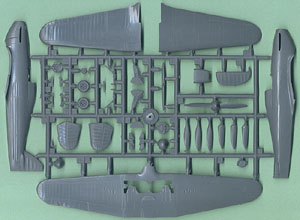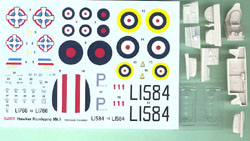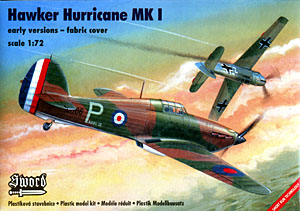Sword's 1/72 Hawker Hurricane Mk.I Early | | History The Hawker Hurricane is one of the most famous planes of the Second World War, with most of its notoriety being gained during the Battle of Britain. While later on during the war it was often overshadowed by the Spitfire, the Hurricane soldiered on right up to the last days of the war, fighting on all fronts. The Hurricane built upon Hawker's earlier designs and featured mostly fabric construction, with only the forward fuselage and other small areas being metal covered. The benefits of metal covering quickly became apparent and the vast majority of Hurricanes had the fabric areas reduced to the rear fuselage and control surfaces. Armament originally was in the form of machine guns in the wing, but later variants expanded this to a pair of 20mm cannons in each wing in the Mk. IIC. Other weaponry carried included rockets and underwing cannons. The Hurricane fought over the skies of Europe and Asia from England to Australia, in the air forces of Britain, France, Russia, United States, Yugoslavia, and several others. It may not have been the most modern design leading into the Second World War, but it could do just about any job thrown at it.  The Kit The Kit This is the first injection-molded kit of the early Mk. I Hurricane that I can think of. I am surprised that someone hasn't come out with a kit of this version, what with all the recent Hurricane releases in the last few years. This kit has a combination of injection-molded parts and resin details, with a nice decal sheet rounding things out. For those of you who have been getting Sword kits recently, this kit has been done to a bit better quality than their last two, at least in regards to the plastic parts. The plastic is harder and the moldings are much crisper. There is still going to be some cleaning up to do, though. The kit is broken down in a manner similar to other Hurricane kits, with a right and left fuselage side, one-piece lower wing, and separate right and left upper halves. One part that I found problems with was with the vertical tail. Sword decided to mold this as one piece on one of the fuselage halves. Normally this wouldn't be too much of a problem but in my example the molds weren't aligned right, resulting in the right side of the tail being about 1/8" farther back and down. This will be very difficult to correct, and probably the simplest course of action will be to cut it off and replace it with one from a different kit. The cockpit is nicely done, being entirely resin. Once painted up it will really look good. Of course, once it's in the kit and the fuselage is together, much of this detail won't be seen. Other resin parts include the wheel well inserts, belly radiator and chin scoops, and early-style exhaust stacks. All are very well cast and will help a great deal in making this Hurricane look great. The only thing I wish was cast in resin but wasn't was the propellers. This kit gives you three choices, the Watts two-bladed one and a pair of three-bladed ones. The three-bladed ones feature separate blades that you'll have to align just right, and the Watts has a rear plug that will be a challenge to blend in. Still, they do look accurate and it beats scratchbuilding one, that's for sure!  The big thing for this kit is the fabric wing, of course, and this is nicely done. There is no fabric texture and the ribbing is nicely done, not too heavy and not too light. If you were thinking of perhaps just putting this wing on a Hasegawa kit, I'm afraid it's not that simple. You'd also need to change the nose and rudder as well, and use the canopy from the Sword kit (unarmored example). Besides, the fabric work on the rear fuselage is much better than that in the Hasegawa kit. The big thing for this kit is the fabric wing, of course, and this is nicely done. There is no fabric texture and the ribbing is nicely done, not too heavy and not too light. If you were thinking of perhaps just putting this wing on a Hasegawa kit, I'm afraid it's not that simple. You'd also need to change the nose and rudder as well, and use the canopy from the Sword kit (unarmored example). Besides, the fabric work on the rear fuselage is much better than that in the Hasegawa kit.
The decal sheet is nicely printed and provides decals for three Hurricanes. The first is from No. 111 Squadron, based at Northolt in 1938. The instructions state that it should be camouflaged in dark green and dark brown over sky. This is 2/3rds correct. On the early Hurricanes the undersides were painted aluminum rather than sky, and this is true for the other two options included in the decals. The second choice is "Paddy III", an early Hurricane flown by Edgar James Kain of 73 Squadron in France, 1940. This example features a slightly different underside scheme, with a white/black lower wing and sky rear fuselage and nose (again, should be aluminum). The final example is a Yugoslav Hurricane, finished in the standard camouflage. Each one of these uses a different propeller, but in my quick research I found that you could probably use the early Watts propeller on all of them. Conclusion While this kit does have some faults and it won't be an easy kit to build, it does look to be a very accurate early Mk.I Hurricane. The subtle differences between this and the later Mk.I Hurricanes will make this model an interesting one to set next to your Battle of Britain Hurricanes, maybe even nose-to-nose with the new Tamiya Bf109E-3. And to make things even better you'll be left with plenty of parts for your spares box (spare exhausts and spare props)! | 


 



  
    |

 The Kit
The Kit The big thing for this kit is the fabric wing, of course, and this is nicely done. There is no fabric texture and the ribbing is nicely done, not too heavy and not too light. If you were thinking of perhaps just putting this wing on a Hasegawa kit, I'm afraid it's not that simple. You'd also need to change the nose and rudder as well, and use the canopy from the Sword kit (unarmored example). Besides, the fabric work on the rear fuselage is much better than that in the Hasegawa kit.
The big thing for this kit is the fabric wing, of course, and this is nicely done. There is no fabric texture and the ribbing is nicely done, not too heavy and not too light. If you were thinking of perhaps just putting this wing on a Hasegawa kit, I'm afraid it's not that simple. You'd also need to change the nose and rudder as well, and use the canopy from the Sword kit (unarmored example). Besides, the fabric work on the rear fuselage is much better than that in the Hasegawa kit.






